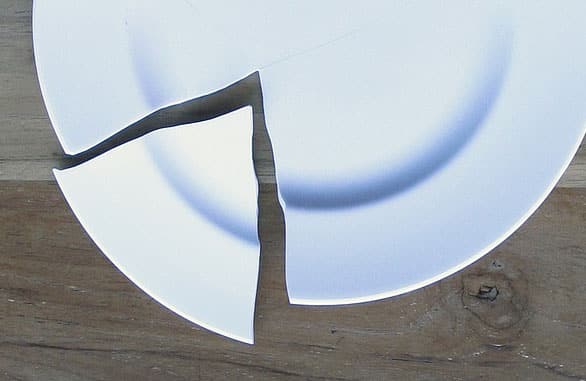Within the large umbrellas of household, construction and commercial waste, there are many niche sectors of waste. Ceramics or ceramic waste can be found in a number of these categories, including e-waste, white goods and builder’s waste. This is because ceramics can be a part of many different household and uncommon items, including electronics, sporting goods, art pieces and even dentistry.
From properly handling the pieces to finding the right disposal method, we will provide step-by-step instructions on how to safely and responsibly dispose of broken ceramics.

What is Considered a Ceramic?
A ceramic is a material that is neither organic nor metal. Formed with heat, ceramics can be crystalline, glassy or both crystalline and glassy. Typically hard and chemically non-reactive, ceramics can be used for a myriad of purposes.
Pottery and dishes are the most common form of ceramics and include clay, bricks, tiles, glass and cement. Ceramics are also commonly used to make up electronic products, as they can be semiconducting, superconducting, ferroelectric, or an insulator. It can also be used to make spark plugs, cooktops, fibre optics and even snow skis.
Are Ceramics Recyclable?
Many different ceramics can be recycled or repurposed. Ceramics can make up other kinds of waste, meaning that the sorting of recyclables can separate the ceramic material from the item for repurposing.
Household items such as old dishes, porcelain decor, vases and even outdoor pots made from terracotta or concrete are considered ceramics and can easily be crushed down and repurposed for future use. Repurposing construction materials such as cement and old bricks is another big part of ceramic recycling.
Methods of disposal
While all ceramic waste disposal options endeavour to recycle elements of ceramic materials, some options are more beneficial than others.
Council Collection and Pick Up
Your local council will usually have collection points for several different kinds of waste that contain ceramic materials like e-waste, household waste and construction waste.
Pick-up services from the council can be done annually or bi-annually. It is always best to check your local council website to find dates and the kinds of rubbish they are willing to pick up.
Taking It to the Tip
Of course, taking your rubbish to the local tip is always an option. Taking rubbish to the tip yourself is great if you have a large amount of garbage to dispose of. The tip may not take recycling into account, so adding to landfill can be a problem when disposing of ceramic products and materials at the tip. However, it is a great solution for larger amounts of waste that won’t fit in the bin.
Be warned; if you have many different kinds of waste to get rid of, you will have to sort the waste yourself!
Collection Services
A rubbish removal service is the way to go for any amount and type of rubbish. At 1300 Rubbish, waste disposal is our forte, with recycling and sustainability a top priority!
Our waste collection services cover all kinds of household waste disposal, including general waste, recycling and green waste. This means that any ceramics or items with ceramic materials in them will be sorted and processed properly at one of the recycling depots we work with. We offer our services nationwide with our locations for rubbish removal services based mainly in urban and city areas.
Broken Ceramic Disposal
Broken ceramics can be a problem when it comes to rubbish removal. Broken glass, clay or porcelain can be especially tricky as it is a safety hazard.
For safe disposal of broken ceramics, make sure to put them in a box, preferably cardboard, with a label. Whether you’re taking it to the tip, dropping it at a council collection point or hiring a collection service, it is important to inform anyone that is handling broken ceramics about the safety hazard.
Re-Using Ceramics
If you have broken ceramics that are tiles or plates or have interesting designs, re-using may be a great option for you.
Making Art
Creating mosaics, art pieces or even crushing ceramics back down into clay is another way to recycle your broken ceramics. If you have an old plate with an interesting design or a set of broken tiles, making art from your waste ensures it doesn’t go to landfill and gives you something nice to hang on the wall!
Of course, making sure you have all the necessary equipment; glue, hammer, and safety apparel, as well as taking the necessary precautions for safety, are extremely important. To break down larger ceramic or porcelain pieces, laying an old towel on top of broken items ensures that no shards can cut you.
Donation
If your household ceramics are in good condition, donating to a local charity or op-shop could be a great way to dispose of your waste. Unwanted plates, mugs, an incomplete set of glasses and other ceramic kitchen items are always wanted for reuse. Even chipped or cracked items can be donated, provided that they are not fully broken and can still serve their purpose.
If you want to make a little money from your waste, your trash might be someone else’s treasure! Selling your old ceramics, whether it’s leftover tiles from a renovation, crockery, or a nice vase, is a great way to earn some cash. Why not have a garage sale or sell your items through an online marketplace? Of course, make sure the items you hope to sell are not broken or unusable.

